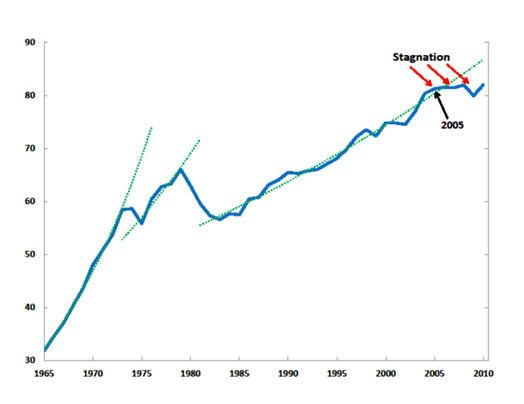Peak oil may already be here, and the knock on effect could range from bad to truly awful

Tightening oil supply could have larger implications on the world economy, with a large shock scenario capable of knocking off a full percentage point in annual GDP in both the eurozone and the USA, according to an IMF study.
A highly readable report by Michael Kumhof and Dirk Muir, Oil and the World Economy: Some Possible Futures, examines how worse off countries would be with less oil supply.
The authors emphasize that oil is a lynchpin for economic growth and a supply disruption has wide ramifications.
Oil is just not about gas for cars: it is the primary liquid transportation fuel for all modes of transportation and a feedstock for the chemical industry. There are substitutes like coal, nuclear and renewables, but they all still have significant drawbacks.
“Over the past decade the world economy has experienced a persistent increase in oil prices. While part of this may have been due to continued rapid demand growth in emerging markets, stagnant supply also played a major role,” writes the authors, noting that the easy oil reserves have already been exploited.

World Crude Oil Production (in million barrels per day). Graph from Oil and the World Economy: Some Possible Futures
The author’s baseline scenario assumes decline in oil production by just one percentage point.
“The shock generates an immediate oil price spike of over 60 percent,” writes the authors.
“This reflects the very low short-term price elasticity of oil demand. Because the decline in supply is persistent, the real oil price continues to increase thereafter, as market equilibrium requires ongoing demand destruction.”
High oil prices don’t just beat up the importers. Exporters suffer as well.
“With rising oil prices, oil exporters experience sustained increases in income and wealth. Higher spending leads to upward domestic price pressures and a large real appreciation. This ‘Dutch disease’ effect reduces output in the tradables sector (other than oil), thereby reducing GDP by up to 7 percent below trend over the first five years, and by almost 10 percent after 20 years.”
That was the bad scenario. The large shock scenario is far worse:
The second alternative scenario . . . considers the implications of a 3.8 percent rather than 1 percent annual decline in world oil output growth. Given an initial growth rate of 1.8 percent per annum in the data, this implies that, except for the small supply response to higher oil prices, oil production declines by 2 percent annually. We also assume that this outright output contraction is accompanied by an annual increase in real extraction costs per barrel of 4 percent rather than 2 percent.
In this scenario, the longer-term output and current account effects are approximately four times as large as in the baseline, in other words they increase roughly in proportion to the size of the shock. Declines in absorption in oil importers now average around 2 percent annually over the period shown, rather than 0.5 percent as in the baseline. Annual GDP growth rates in the United States and the euro area drop by around one percentage point, rather than 0.25 percentage points as in the baseline. Current account deteriorations in oil importers are also much more serious, averaging 5 percentage points of GDP on average in the long term in both the United States and the euro area. The most striking aspect of this scenario is however that supply reductions of this magnitude would require a more than 200 percent increase of the oil price on impact, and an 800 percent increase over 20 years. Relative price changes of this magnitude would be unprecedented, and would almost certainly have nonlinear effects on GDP that the model is not able to capture adequately. Furthermore, the increase in world savings implied by this scenario is so large that several regions could, after the first few years, experience nominal interest rates that approach zero, which could create difficulties for the conduct of monetary policy.
More News
{{ commodity.name }}
{{ post.title }}
{{ post.date }}

3 Comments
stopthesocialism
Proven oil reserves are growing, not diminishing. This would not be likely is URR was only 2 trillion barrels as Hubbert predicted. Oil production will eventually decline from a lack of demand, not from a lack of supply.
Higher oil prices are actually being caused by devalued currencies. This is why other commodities like gold, and silver, have also increased in price.
Dag Johansen
I believe we are already seeing the effects of peak conventional oil. If oil had risen at the rate of inflation since 2000, oil would be $30/barrel range. Instead it is in the $100/barrel range. Now this has not destroyed the world economy, but it is a huge headwind that has slowed growth to a crawl in Europe and the USA. This may be the reason we cannot seem to start growing again.
Wide Publishing
Peak oil is in discussion for a long time.If peak oil is there Dutch disease is likely to follow.It is not the time for the politics that we have all around-bad politics!It is time to be serious ,for action.